
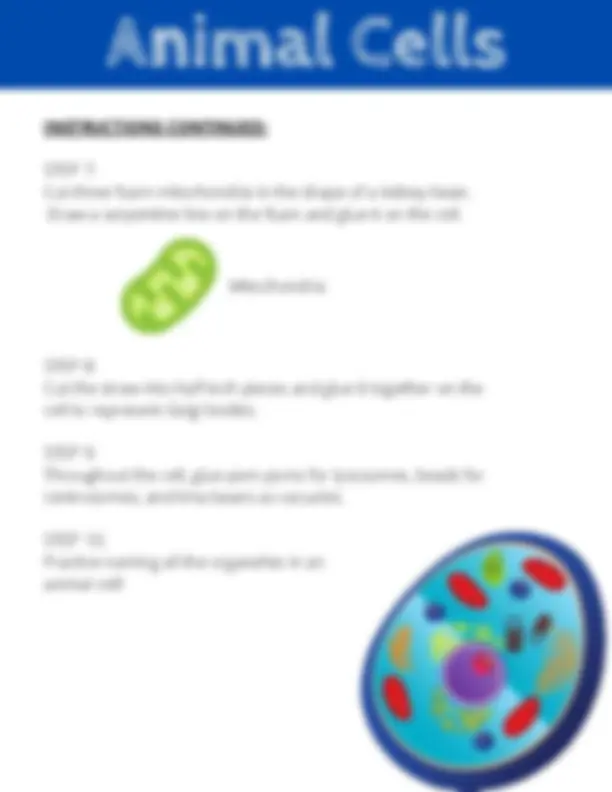
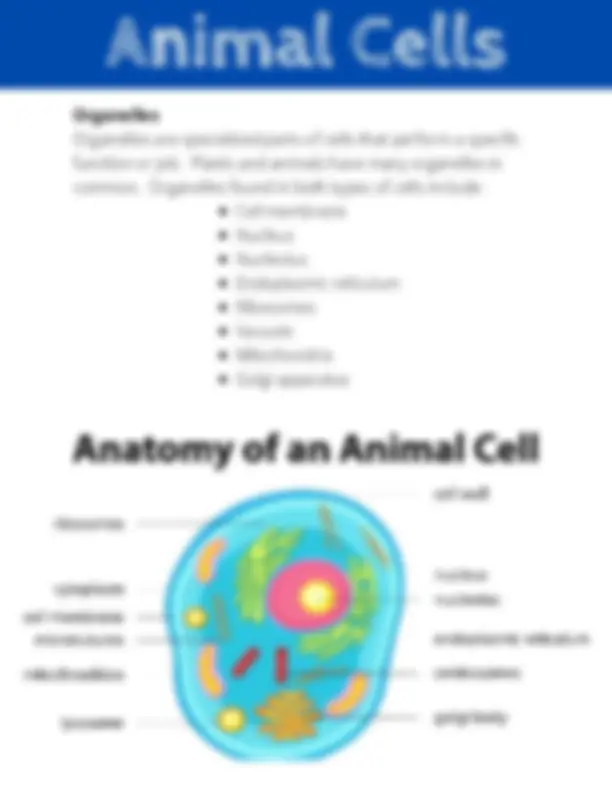
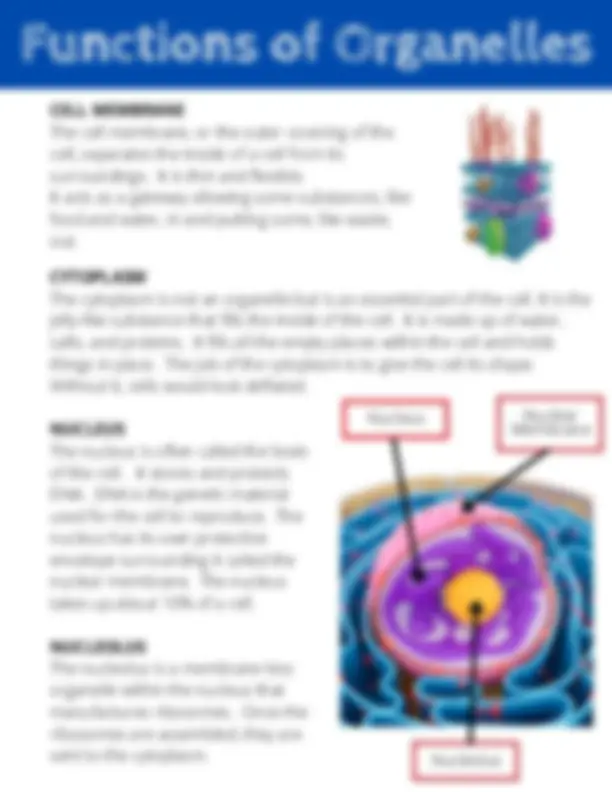
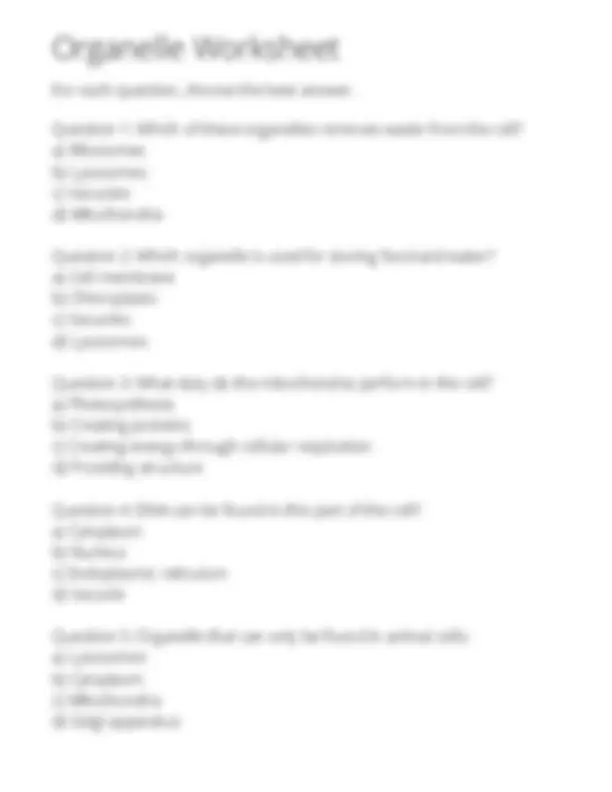
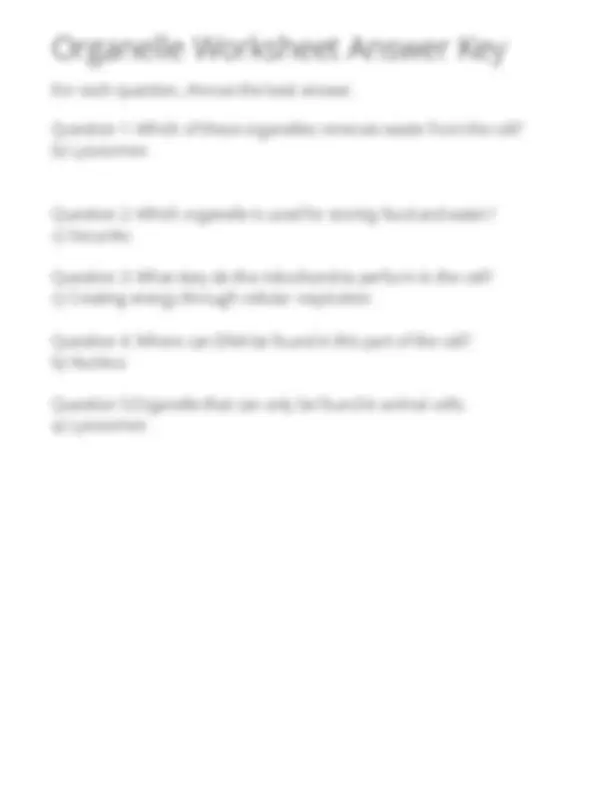


Study with the several resources on Docsity

Earn points by helping other students or get them with a premium plan


Prepare for your exams
Study with the several resources on Docsity

Earn points to download
Earn points by helping other students or get them with a premium plan
Community
Ask the community for help and clear up your study doubts
Discover the best universities in your country according to Docsity users
Free resources
Download our free guides on studying techniques, anxiety management strategies, and thesis advice from Docsity tutors
ANIMAL CELL MODEL EXAMPLE: Animal Cells. Mitochondria. Endoplasmic. Reticulum. Lysosome. Ribosomes. Cytoplasm. Vacuole. Cell. Membrane. Nucleus. Nucleolus.
Typology: Exams
1 / 9

This page cannot be seen from the preview
Don't miss anything!






Foam or construction paper One Straw Curling Ribbon Pom-poms Markers or crayons Yarn Dried Lima Beans Bottle Cap Paper Plate
Mitochondria Endoplasmic Reticulum Lysosome Ribosomes Cytoplasm Vacuole Cell Membrane Nucleus Nucleolus Golgi apparatus
Color the paper plate a solid color for the cytoplasm. STEP 2: Cut and glue a length of yarn around the edge of the plate for the cell membrane. STEP 3: Using a black crayon draw small dots or glue on small plastic beads sporadically around the plate, these dots represent ribosomes. STEP 4: Cut a 2" circle out of construction paper or tissue paper, and glue it near the center of the plate to represent the nucleus. STEP 5: Glue the bottle cap near the center of the nucleus to represent the nucleolus. STEP 6: Create the endoplasmic reticulum by folding the curling ribbon on itself several times. Glue this beside the nucleus.
Cell membrane Nucleus Nucleolus Endoplasmic reticulum Ribosomes Vacuole Mitochondria Golgi apparatus Organelles Organelles are specialized parts of cells that perform a specific function or job. Plants and animals have many organelles in common. Organelles found in both types of cells include:
The cell membrane, or the outer covering of the cell, separates the inside of a cell from its surroundings. It is thin and flexible. It acts as a gateway allowing some substances, like food and water, in and putting some, like waste, out.
The cytoplasm is not an organelle but is an essential part of the cell. It is the jelly-like substance that fills the inside of the cell. It is made up of water, salts, and proteins. It fills all the empty places within the cell and holds things in place. The job of the cytoplasm is to give the cell its shape. Without it, cells would look deflated. NUCLEUS The nucleus is often called the brain of the cell. It stores and protects DNA. DNA is the genetic material used for the cell to reproduce. The nucleus has its own protective envelope surrounding it called the nuclear membrane. The nucleus takes up about 10% of a cell. NUCLEOLUS The nucleolus is a membrane-less organelle within the nucleus that manufactures ribosomes. Once the ribosomes are assembled, they are sent to the cytoplasm. Nucleus Nucleolus Nuclear Membrane
Mitochondria are rod-shaped organelles that function as a cell's power plant. They have two membranes that help convert food into energy that the cell can use. The process of creating this energy is called cellular respiration. Mitochondria can move around the cell and increase in numbers when the cell needs more energy. VACUOLES Vacuoles store water, food, and other molecules. In plants, vacuoles can occupy up to 90% of the cell's space. They help cells maintain their stiff structure. ORGANELLE ONLY FOUND IN ANIMAL CELLS LYSOSOMES Lysosomes are the garbage disposals of the cell. They have chemicals that break down food, cell waste, and foreign particles that enter the cell. They digest and destroy dead cells or old cell parts and recycle them to make material for other cells.
Question 1: Which of these organelles removes waste from the cell? a) Ribosomes b) Lysosomes c) Vacuoles d) Mitochondria Question 2: Which organelle is used for storing food and water? a) Cell membrane b) Chloroplasts c) Vacuoles d) Lysosomes Question 3: What duty do the mitochondria perform in the cell? a) Photosynthesis b) Creating proteins c) Creating energy through cellular respiration d) Providing structure Question 4: DNA can be found in this part of the cell? a) Cytoplasm b) Nucleus c) Endoplasmic reticulum d) Vacuole Question 5: Organelle that can only be found in animal cells: a) Lysosomes b) Cytoplasm c) Mitochondria d) Golgi apparatus For each question, choose the best answer.